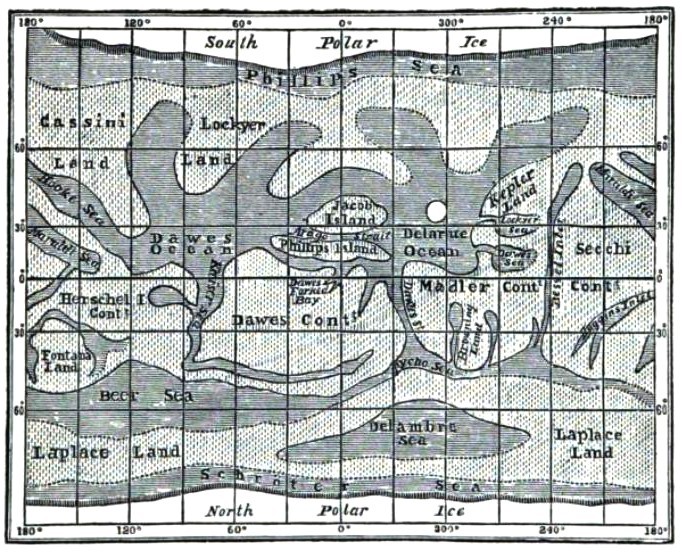Mare Erythraeum on:
[Wikipedia]
[Google]
[Amazon]
Mare Erythraeum is a very large dark dusky region of
"Mars"
(1895) Under the name of De La Rue Ocean it was included in Procter's 1905 map of Mars.
Under the name of De La Rue Ocean it was included in Procter's 1905 map of Mars.
Google Mars zoomable map centered on Mare Erythraeum
Albedo features on Mars Margaritifer Sinus quadrangle {{crater-stub
Mars
Mars is the fourth planet from the Sun and the second-smallest planet in the Solar System, only being larger than Mercury. In the English language, Mars is named for the Roman god of war. Mars is a terrestrial planet with a thin atmosp ...
that can be viewed by even a small telescope
A telescope is a device used to observe distant objects by their emission, absorption, or reflection of electromagnetic radiation. Originally meaning only an optical instrument using lenses, curved mirrors, or a combination of both to observ ...
. The name comes from the Latin
Latin (, or , ) is a classical language belonging to the Italic branch of the Indo-European languages. Latin was originally a dialect spoken in the lower Tiber area (then known as Latium) around present-day Rome, but through the power of the ...
for the Erythraean Sea
The Erythraean Sea ( grc-gre, Ἐρυθρὰ Θάλασσα, ''Erythrà Thálassa'', ."Red Sea") was a former maritime designation that always included the Gulf of Aden and at times other seas between Arabia Felix and the Horn of Africa. Original ...
, because it was originally thought to be a large sea of liquid water. It was included in Percival Lowell
Percival Lowell (; March 13, 1855 – November 12, 1916) was an American businessman, author, mathematician, and astronomer who fueled speculation that there were canals on Mars, and furthered theories of a ninth planet within the Solar System. ...
's 1895 map of Mars.Lowell, Perciva"Mars"
(1895)
 Under the name of De La Rue Ocean it was included in Procter's 1905 map of Mars.
Under the name of De La Rue Ocean it was included in Procter's 1905 map of Mars.
See also
*Geography of Mars
Areography, also known as the geography of Mars, is a subfield of planetary science that entails the delineation and characterization of regions on Mars. Areography is mainly focused on what is called physical geography on Earth; that is the di ...
References
External links
Google Mars zoomable map centered on Mare Erythraeum
Albedo features on Mars Margaritifer Sinus quadrangle {{crater-stub